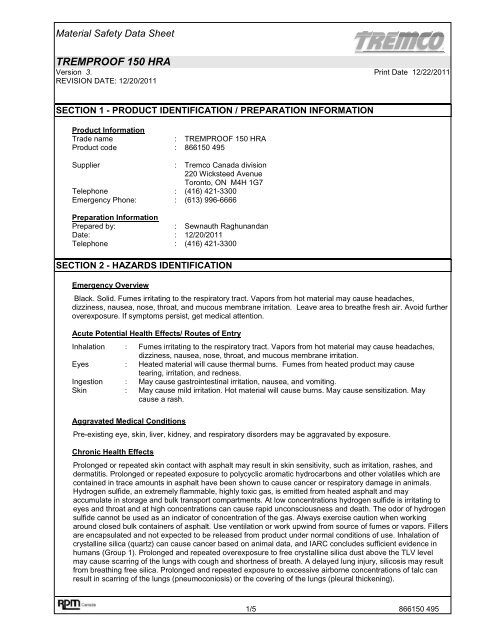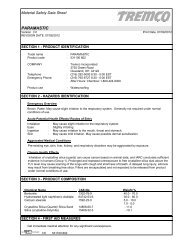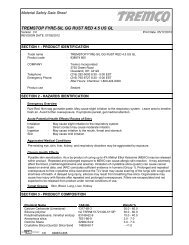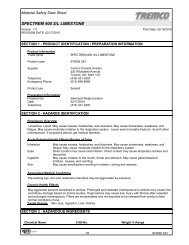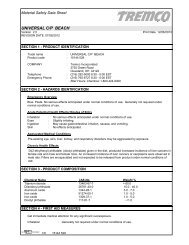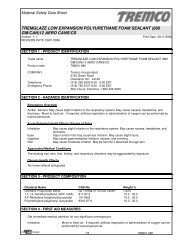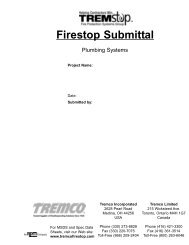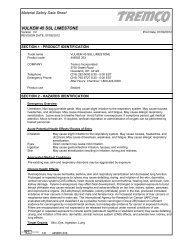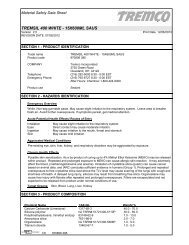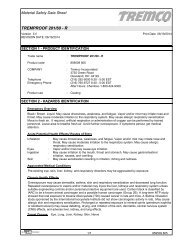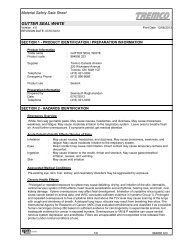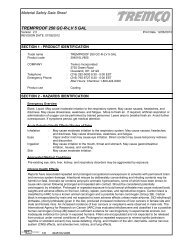TREMPROOF 150 HRA - Tremco Sealants
TREMPROOF 150 HRA - Tremco Sealants
TREMPROOF 150 HRA - Tremco Sealants
You also want an ePaper? Increase the reach of your titles
YUMPU automatically turns print PDFs into web optimized ePapers that Google loves.
Material Safety Data Sheet<strong>TREMPROOF</strong> <strong>150</strong> <strong>HRA</strong>Version 3. Print Date 12/22/2011REVISION DATE: 12/20/2011SECTION 1 - PRODUCT IDENTIFICATION / PREPARATION INFORMATIONProduct InformationTrade name : <strong>TREMPROOF</strong> <strong>150</strong> <strong>HRA</strong>Product code : 866<strong>150</strong> 495Supplier : <strong>Tremco</strong> Canada division220 Wicksteed AvenueToronto, ON M4H 1G7Telephone : (416) 421-3300Emergency Phone: : (613) 996-6666Preparation InformationPrepared by: : Sewnauth RaghunandanDate: : 12/20/2011Telephone : (416) 421-3300SECTION 2 - HAZARDS IDENTIFICATIONEmergency OverviewBlack. Solid. Fumes irritating to the respiratory tract. Vapors from hot material may cause headaches,dizziness, nausea, nose, throat, and mucous membrane irritation. Leave area to breathe fresh air. Avoid furtheroverexposure. If symptoms persist, get medical attention.Acute Potential Health Effects/ Routes of EntryInhalation : Fumes irritating to the respiratory tract. Vapors from hot material may cause headaches,dizziness, nausea, nose, throat, and mucous membrane irritation.Eyes : Heated material will cause thermal burns. Fumes from heated product may causetearing, irritation, and redness.Ingestion : May cause gastrointestinal irritation, nausea, and vomiting.Skin : May cause mild irritation. Hot material will cause burns. May cause sensitization. Maycause a rash.Aggravated Medical ConditionsPre-existing eye, skin, liver, kidney, and respiratory disorders may be aggravated by exposure.Chronic Health EffectsProlonged or repeated skin contact with asphalt may result in skin sensitivity, such as irritation, rashes, anddermatitis. Prolonged or repeated exposure to polycyclic aromatic hydrocarbons and other volatiles which arecontained in trace amounts in asphalt have been shown to cause cancer or respiratory damage in animals.Hydrogen sulfide, an extremely flammable, highly toxic gas, is emitted from heated asphalt and mayaccumulate in storage and bulk transport compartments. At low concentrations hydrogen sulfide is irritating toeyes and throat and at high concentrations can cause rapid unconsciousness and death. The odor of hydrogensulfide cannot be used as an indicator of concentration of the gas. Always exercise caution when workingaround closed bulk containers of asphalt. Use ventilation or work upwind from source of fumes or vapors. Fillersare encapsulated and not expected to be released from product under normal conditions of use. Inhalation ofcrystalline silica (quartz) can cause cancer based on animal data, and IARC concludes sufficient evidence inhumans (Group 1). Prolonged and repeated overexposure to free crystalline silica dust above the TLV levelmay cause scarring of the lungs with cough and shortness of breath. A delayed lung injury, silicosis may resultfrom breathing free silica. Prolonged and repeated exposure to excessive airborne concentrations of talc canresult in scarring of the lungs (pneumoconiosis) or the covering of the lungs (pleural thickening).1/5 866<strong>150</strong> 495
Material Safety Data Sheet<strong>TREMPROOF</strong> <strong>150</strong> <strong>HRA</strong>Version 3. Print Date 12/22/2011REVISION DATE: 12/20/2011Target Organs: Skin, Lung, Eye, Liver, KidneySECTION 3 : HAZARDOUS INGREDIENTSChemical Name CAS-No. Weight % RangeAsphalt 64741-56-6 40.0 - 70.0Crystalline Silica (Quartz)/ Silica Sand 14808-60-7 0.1 - 1.0The ingredients listed above are hazardous as defined in the controlled products regulation. (CPR).SECTION 4 - FIRST AID MEASURESGet immediate medical attention for any significant overexposure.Inhalation : Leave area to breathe fresh air. Avoid further overexposure. If symptoms persist, getmedical attention.Eye contact : Flush with water for at least 15 minutes while holding eye lids apart. Get medicalattention immediately.Skin contact : If hot material strikes the skin, immediately drench or immerse the area in water toassist cooling. If available, apply iced water or ice packs to the burned area. (DONOT use iced water or ice packs if the burned area covers greater than 10% of thebody, as this may contribute to shock.) DO NOT try to remove asphalt from a burnafter it has cooled. Seek medical attention. Medical personnel can soften andremove cooled asphalt with petroleum jelly. For contact with cold material, clean witha waterless hand cleaner, then wash with mild soap and water. If irritation persists,seek medical attention.Ingestion : Do not induce vomiting unless advised by a physician. Call nearest Poison ControlCenter or Physician immediately.SECTION 5: FIRE / EXPLOSION HAZARDSFlash point : > 200 °C, > 392 °FMethod : Cleveland Open CupLower explosion limit : Not available.Upper explosion limit : Not available.Autoignition temperature : Not available.Extinguishing media : If water fog is ineffective, use carbon dioxide, dry chemical or foam.Hazardous combustionproductsProtective equipment forfirefighters: Smoke, fumes.Carbon monoxide and carbon dioxide can form.Oxides ofsulfur can form.: Use accepted fire fighting techniques. Wear full firefighting protectiveclothing, including self-contained breathing apparatus (SCBA).Fire and explosion conditions : This product not expected to ignite under normal conditions ofuse.Product may ignite if heated in excess of its flash point.SECTION 6 - SPILLS / LEAKS / ACCIDENTAL RELEASE MEASURESUse appropriate protective equipment. Avoid contact with material. If hot, stop flow. Contain spill. Keep out ofwater courses. Allow material to cool. Scrape up and transfer to appropriate container for disposal.2/5 866<strong>150</strong> 495
Material Safety Data Sheet<strong>TREMPROOF</strong> <strong>150</strong> <strong>HRA</strong>Version 3. Print Date 12/22/2011REVISION DATE: 12/20/2011SECTION 7 - HANDLING AND STORAGEDuring manufacture, caution must be used to prevent contact with hot material. Prevent inhalation of vapor.Product is heated during processing. Avoid contact with hot material. Wear heat resistant gloves. Do not inhalevapor or fumes. In case of contact with skin or eyes, apply cold water immediately and get medical attention assoon as possible. Do not heat in excess of the flash point. Do not use in confined or poorly ventilated areas.Store in sealed containers in a cool, dry, ventilated warehouse location.SECTION 8 - PREVENTIVE MEASURES/EXPOSURE CONTROLS/PERSONAL PROTECTIONPersonal protection equipmentRespiratory protection : Wear NIOSH/MSHA approved vapor respirator with appropriate cartridgewhen the vapor concentration is expected to exceed exposure limits indicatedon the MSDS. Follow manufacturer's directions for respirator use.Hand protection : Use heat resistant gloves and protective apparel for hot material.Eye protection : Wear appropriate eye protection.Wear chemical safety goggles and/or faceshield to prevent eye contact. Do not wear contact lenses. Do not touch eyeswith contaminated body parts or materials. Have eye washing facilities readilyavailable.Skin and body protection : Use a face shield impervious to hot bitumenUse slip resistant shoesimpervious to hot bitumen.Protective measures : Use professional judgment in the selection, care, and use.During torchapplication, protect hands with heat resistant gloves and use slip resistantshoes impervious to hot bitumen. Protect hands with suitable gloves whenhandling finished product.Engineering measures : Use general ventilation and/ or local exhaust to reduce the airbornecontaminant concentration below the exposure limit listed in the MSDSExposure LimitsChemical Name CAS Number Regulation Limit FormCrystalline Silica (Quartz)/ 14808-60-7 Ontario TWAEV: 0.10 mg/m3 Respirable fraction.Silica SandACGIH TWA: 0.025 mg/m3 Respirable fraction.SECTION 9 - PHYSICAL AND CHEMICAL PROPERTIESPhysical StateFormColorOdorpHVapour pressureVapor densityMelting point/rangeFreezing point: Solid: Solid: Black: Asphalt: Not available.: Not available.: Heavier than air: Not available.: Not available.3/5 866<strong>150</strong> 495
Material Safety Data Sheet<strong>TREMPROOF</strong> <strong>150</strong> <strong>HRA</strong>Version 3. Print Date 12/22/2011REVISION DATE: 12/20/2011Boiling point/rangeWater solubilityEvaporation Rate:: Not available.: Insoluble: Not available.Specific Gravity : 1.279% Volatile Weight : 3 %SECTION 10 - REACTIVITY / STABILITYSubstances to avoidStabilityHazardous polymerization: Oxidizing agents.: Material is stable under normal storage, handling, and use.: Will not occur.SECTION 11 - TOXICOLOGICAL INFORMATIONNo Data AvailableSECTION 12 - ECOLOGICAL INFORMATIONNo Data AvailableSECTION 13 - WASTE DISPOSAL CONSIDERATIONSDisposal Method : Dispose as hazardous waste according to all local, state, federal and provincialregulations.SECTION 14 - TRANSPORTATION / SHIPPING DATATDG / DOT Shipping Description:NOT REGULATEDSECTION 15 - REGULATORY INFORMATIONNorth American Inventories:All components are listed or exempt from the TSCA inventory.This product or its components are listed on, or exempt from the Canadian Domestic Substances List.Canadian Regulations:WHMIS Classification : D2AThis is a "controlled product" under the Canadian Workplace Hazardous Materials Information System(WHMIS).This product has been classified in accordance with the hazard criteria of the Controlled Products Regulations(CPR) and the MSDS contains all of the information required by the CPR.Other Regulations:4/5 866<strong>150</strong> 495
Material Safety Data Sheet<strong>TREMPROOF</strong> <strong>150</strong> <strong>HRA</strong>Version 3. Print Date 12/22/2011REVISION DATE: 12/20/2011Regulatory VOC (less water andexempt solvent): 44 g/lSECTION 16 - OTHER INFORMATIONHMIS Rating :Health 1 0 = MinimumFlammability 11 = SlightReactivity 02 = ModeratePPE3 = Serious4 = SevereFurther information:For Industrial Use Only. Keep out of Reach of Children. The hazard information herein is offered solely for theconsideration of the user, subject to their own investigation of compliance with applicable regulations, includingthe safe use of the product under every foreseeable condition.Prepared by: Sewnauth RaghunandanLegendACGIH - American Conference of Governmental HygienistsDOT - Department of TransportationDSL - Domestic Substance ListEPA - Environmental Protection AgencyHMIS - Hazardous Materials Information SystemIARC - International Agency for Research on CancerMSHA - Mine Safety Health AdministrationNDSL - Non-Domestic Substance ListNIOSH - National Institute for Occupational Safety and HealthNTP - National Toxicology ProgramOSHA - Occupational Safety and Health AdministrationPEL - Permissible Exposure LimitRCRA - Resource Conservation and Recovery ActSTEL - Short Term Exposure LimitTLV - Threshold Limit ValueTSCA - Toxic Substances Control ActTWA - Time Weighted AverageV - VolumeVOC - Volatile Organic CompoundWHMIS - Workplace Hazardous Materials Information System5/5 866<strong>150</strong> 495


